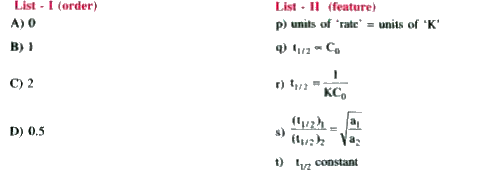The concentrationfo R in the reaction R→P was measured as a function of time and the following data is obtained:
[R] (molar) 1.0 0.75 0.40 0.10
t(min) 0.0 0.05 0.12 0.18
The order of the reactionis Solution in Telugu
The correct Answer is:0
(−dA)/(dt)1(−dA/dt)2=(C1C2)n,(025/0.05)(0.35/0.07)(10.75)1,0.250.05×0.070.35=(10075)n,25×75×35=(43)n
77=(43)n⇒ may be zero order
r1=(−dA(dt)1)=0.250.05=255=5,r2=(−dAdt)2=0.350.07=357=5 zero order ⇒r1=r2
Topper's Solved these Questions
- BOOK - AAKASH SERIESCHAPTER - CHEMICAL KINETICSEXERCISE - PRACTICE SHEET-1 (SINGLE OR MORE THAN ONE OPTION QUESTIONS)16videos
CHEMICAL KINETICS
- BOOK - AAKASH SERIESCHAPTER - CHEMICAL KINETICSEXERCISE - PRACTICE SHEET-1 (LINKED COMPREHENSION TYPE QUESTIONS)6videos
CHEMICAL KINETICS
- BOOK - AAKASH SERIESCHAPTER - CHEMICAL KINETICSEXERCISE - LEVEL-II(LECTURE SHEET EXERCISE-III MATCH THE FOLLOWING QUESTIONS)3videos
CHEMICAL KINETICS
- BOOK - AAKASH SERIESCHAPTER - CHEMICAL KINETCSEXERCISE - EXERCISE - 3.245videos
CHEMICAL KINETCS
- BOOK - AAKASH SERIESCHAPTER - CHEMICAL THERMODYNAMICSEXERCISE - Additional Practice Exercise54videos
CHEMICAL THERMODYNAMICS
Similar Questions
For the reaction N2+3H2→2NH3 , the rate d[NH3]dt=2×10−4Ms−1. Therfore the rate −d[N2]dt is given
04:16View SolutionThe instantaneous rate of an elementary chamical reactkon aA+bB⇔cC+dD can be given by rate =Kf[A]a[B]b−Kb[C]c[D]d where Kf and Kb are rate constants for forward and backward reactions respectively for the reversible reaction. If the reaction is an irreversible one, the rate is expressed as, rate =K[A]a[B]b where K is rate contant for the given irreversible rate of disappearance of A is a/b times the rate of disappearance of B. The variation of rate constant K with temperature is expressed in terms of Arrhenius equation: K=Ae−Ea/RT whereas the ratio KfKb is expressed in terms of van't Hoff isochore: KfKb=Ae−ΔH/RT, where Ea and ΔH are energy of activation and heat of reaction respectively.
The variation of rate constant K and KfKb with temperature shows the following effects:
For endothrmic reaction when T increases then K increases and KfKb also increases.
(ii) For endothemic reaction when T decreases then K decreases and KfKb also decreases.
(iii) For exothermic when T increases then K and KfKb both increases.
(iv) For exothermic reaction when T decreases then K increases and KfKb decrease.
(v) For exothermic reaction when T increases thenK and KfKb both decrease.View SolutionMatch the following columns
 04:44View Solution
04:44View SolutionDiscuss on the kinetic spontaneity of a chemical reaction. Is a slow reaction spontaneous? Why?
View SolutionWhich among the following is not an exact differential?
02:12View SolutionThe concentration of R in the reaction R→P was measured as a function of time and the following data were obtained. What is the order of the reaction?
∣∣∣[R](mol)1.00.750.400.10T(min)0.00.050.120.18∣∣∣06:40View SolutionThe concentration of R in the reaction R to P was measured as a funcation of time and the following data is obtained:
03:18View SolutionFor a reaction between A and B, the initial rate of reaction is measured for various initial concentration of A and B. The data provided are {:("[A]","[B]","Initial reaction rate"),("(a) 0.02 M","0.30 M",5xx10^(-5)),("(b) 0.20 M","0.10 M",5xx10^(-5)),("(c) 0.40 M","0.05 M",1xx10^(-4)):} The overall order of the reaction is
03:00View SolutionThe concentration R in the reaction RtoP was measured as a function of time and the following data is obtained. The order of reaction is
04:57View SolutionThe time for half change fro a gaseous reaction was measured for varous initial pressures and the following data were obtained : {:(p (kPa),26.6,40,53.3),(t"(min)",150,99,75.3):} Find out the order of the reaction
04:49View SolutionFollowing data is obtained in a chemical reaction occuring with a single reactant. The order of the reaction will be (if t1/2=40min,t3/4=360min) :
04:06View SolutionThe concentration of R in the reaction R rarr P was measured as a function of time and the following data was obtained {:("[R]",1,0.5,0.25,0.125),("Time",0,0.05,0.1,0.15):} The order of reaction is :
02:42View SolutionThe concentration of R in the reaction Rrarr P was measured as a function of time and the following data is obtained: The order of the reaction is
03:16View Solutionभिक्रिया R → Pमें, R की सान्द्रता समय के फलन में मापी गयी, और निम्न आंकड़े पाए गए
अभिक्रिया की कोटि है 03:54View Solution
03:54View SolutionThe concentration of "R" in the reaction R→P was measured as a function of time and the following data is obtained [[R]1098.17.29t( minutes )0.0102030]
Order of the reaction is02:43View Solution

